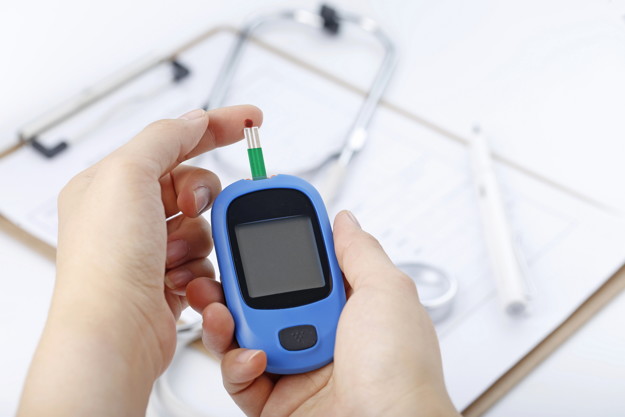Gestational Diabetes
Gestational Diabetes:
It is high glucose (sugar) level in the blood discovered for the first time during pregnancy in a woman unknown to be diabetic before.
During pregnancy, the placenta produces different hormones, some of them make it harder to make Insulin or use it (insulin Resistance).
Symptoms:
Sometimes it does not show any symptoms (asymptomatic).
Symptoms include:
1. Frequent urination.
2. Unusual thirst.
3. Frequent bladder or vaginal infections.
4. Blurred vision.
Risk factors:
1. Close family member history of type 2 diabetes.
2. Gestational diabetes in previous pregnancy.
3. Overweight: BMI more than 30.
4. Previous big baby (more than 4 kg).
5. Advanced age.
6. Excessive weight gain during pregnancy.
7. Pre-eclamsia.
8. High blood pressure.
9. Polyhydramnios.
10. Previous unexplained miscarriage or stillbirth.
11. Hormones disorders.
12. Prediabetes.
When the test for gestational diabetes is done during pregnancy?
Routinely done between week 24 – 28 of pregnancy.
It might be done earlier (around week 8 to 12) if the mother has risk factors.
How the test is done?
A. Two parts test:
Blood sample will be taken one hour after drinking glucose solution.
If sugar level was normal, no need for another test.
If the result was high (140 mg/dL or more), the doctor will do another test called Oral Glucose Tolerance Test (GTT)
Oral Glucose Tolerance Test (GTT):
The mother will be asked to do blood test in the morning before eating anything (fasting for 8-12 hours, drinking water is allowed).
Then another blood test one hour after drinking glucose solution of 100 mg,
then another blood test one , two and three hours later.
The mother will be diagnosed with gestational diabetes if at least two tests are higher than normal.
B. One part test:
Do GTT test of 100 mg one time.
Gestational diabetes is diagnosed when one or more results are higher than normal.
Normal reading:
Less than 95 mg/dl after the first test.
Less than 180 mg/dl after one hour.
Less than 155 mg/dl after two hours.
Less than 140 mg/dl after three hours.
The glucose solution used in the tests may cause nausea and vomiting in some women, These are options for women who can not tolerate it:
1. Serial tests (fasting and one- or two-hour post-meal blood tests obtained in different days).
2. Serial fasting and A1C tests.
3. doing the test after taking antiemetic drug.
Identification of type 2 diabetes in early pregnancy:
The doctor may do type 2 diabetes test in the first prenatal visit if there is a possibility of unrecognized diabetes, specially with risk factor of body mass index ≥25 with one or more of the following risks:
1. Glycated hemoglobin ≥5.7%
2. First-degree relative with diabetes
3. High blood pressure
4. High cholesterol level
5. History of cardiovascular disease
6. Previous birth of baby ≥4 kg
7. PCOS
8. Advanced age
9. Physical inactivity
Glycated hemoglobin A1C:
High hemoglobin level in the blood can indicate and Increase in glucose level.
Treatment:
A. Most mothers with gestational diabetes can normalize sugar level in the blood by healthy diet:
1. Three small to medium size meals and two – four snacks.
2. Eat vegetables low in sugar and carbohydrates such as spinach, broccoli, carrots,tomatoes, onions and mushrooms.
3. Eat whole grains over refined grains in bread, rice and pasta.
4. Eat healthy carbohydrates found in squash, potatoes and corn.
5. Avoid food high in sugar such as candies, jams, dried fruit, flavored yogurt, cakes and sugary drinks.
6. Avoid adding sugar or honey to food and drinks.
7. Limit fruit intake to one small fruit at a time.
8. Limit fresh juice intake to half cup per serving (118 ml).
9. Limit processed food intake.
10. Eat low fat diary products.
11. Protein intake (skinless chicken breast, baked fish) should be distributed between all meals.
12. Make sure to have a snack at bedtime.
Carbohydrate intake: 40٪ of total calories
Protein: 20٪ of total calories
Fat: 40٪ of total calories, less than 7% from saturated fat.
Meals plan example:
Breakfast:
One boiled egg
Small banana
Whole grain piece bread or 1 cup of cereals
Cup of low fat milk
Lunch:
85 gram of chicken breast or tuna can
30 gm of whole grain rice or pasta
Small apple
100 gm of carrots
Dinner:
30 gm of whole grain rice or pasta or sweet potatoes
85 gm of grilled fish or turkey burger
small pear
60 gm of broccoli
Snack 1:
128 gm (one cup) of cucumber with 4 tablespoon of hummus
Snack 2:
Low fat plain yogurt with nuts
The mother is also advised to monitor her sugar level at home four times a day:
before eating in the morning, and one or two hours after breakfast, lunch and dinner.
The frequency of monitoring may decrease to every other day with mild diabetes or if normal sugar level was achieved with nutrition therapy.
Glucose targets with nutritional therapy are:
– Fasting blood glucose concentration: <95 mg/dL.
– One-hour after meal blood glucose concentration: <140 mg/dL.
– Two-hour after meal glucose concentration: <120 mg/dL.
Weight gain and loss:
The mother is advised to pay attention to her weight changes as excessive weight gain is associated with increase risk of having a large infant, preterm birth, and cesarean delivery.
While optimal weight gain helps in avoiding medical therapy for gestational diabetes and decrease the risk of having a large baby.
B. Exercise:
The aim of exercise is to increase muscles mass, and that might help in normalizing glucose level in blood.
It is preferred that exercises have less pressure on joints.
When exercising, the muscles take more glucose in, which lowers glucose level.
Consult your doctor first, most women with no pregnancy related complications will not face any problems with exercising.
If taking any medications to lower high sugar level, talk to your doctor first as exercising may lead to hypoglacymia.
It is advised to check glucose level 30 minutes before exercise. If it was near 90 ml/dL, the mother should eat little bit of carbohydrates.
If pregnant’s condition allows:
a. 20 – 30 minutes three times a week of cardiovascular fitness exercises such as cycling.
b. 30 minutes of low – moderate impact exercises such as aerobics, walking, swimming or resistance exercises 3 – 5 times a week.
C. Medication:
1. Treatment by insulin is started when glucose target levels are not achieved despite the nutritional therapy.
2.Oral antihyperglycemic agents:
Metformin: in second- and third-trimester.
Alternative for mothers who can not follow insulin treatment or refuse to take it.
Helps also in less weight gain and lower blood pressure.
More suitable for mild diabetes.
Side effects are mild, include a metallic taste in the mouth, nausea, or diarrhea.
What to do in case of hypoglycemia?
It is when glucose level is less than 60 mg/dL.
The mother is advised to eat immediately a snack of 10 – 20 g of mixed protein and carbohydrate.
Example: raw carrots with peanut butter.
Whole-grain bread with peanut butter or cheese.
Plain yogurt with nuts.
Avoid eating plain sugar as it can cause rapid increase and then sudden drop in glucose level.
Prenatal visits:
More frequent prenatal visits once every week or two, depending on mother’s and fetal condition.
Non-stress test for the fetus with amniotic fluid index might be done twice weekly, starting from week 32.
Delivery:
Between week 38 and 40 if glucose level is near normal.
Earlier delivery might be planned if glucose level was not controlled during pregnancy.
Glucose level is monitored during labor, and the mother might be given insulin during delivery if needed.
Cesarean delivery might be scheduled if the estimated weight of the fetus is more than 4.5 kg.
Postpartum check up:
All mothers with gestational diabetes should take glucose tolerance test 6 – 12 weeks after delivery.
Women is advised to do diabetes test every 1 – 3 years as they are at higher risk of developing type 2 diabetes.
Recurrence in future pregnancies:
Gestational diabetes tends to occur again in the following pregnancy if:
1. Mother is advancing in age.
2. increase in weight between pregnancies.
Prevention:
The mother with history of gestational diabetes can reduce the risk of developing it again in next pregnancies by following healthy habits with food and exercises.
Gestational diabetes complications:
1. Macrosomia: large baby, weight more than 4 kg which may cause injury to the mother during delivery or needs C-section.
2. Low blood sugar in the newborn.
3. High blood pressure.
4. Polyhydramnios.
5. Stillbirth.
6. Preterm delivery.
7. Newborn Respiratory distress syndrome.
8. Higher risk of future type 2 diabetes with the mother and the baby.



